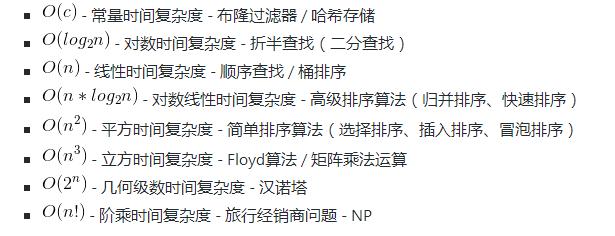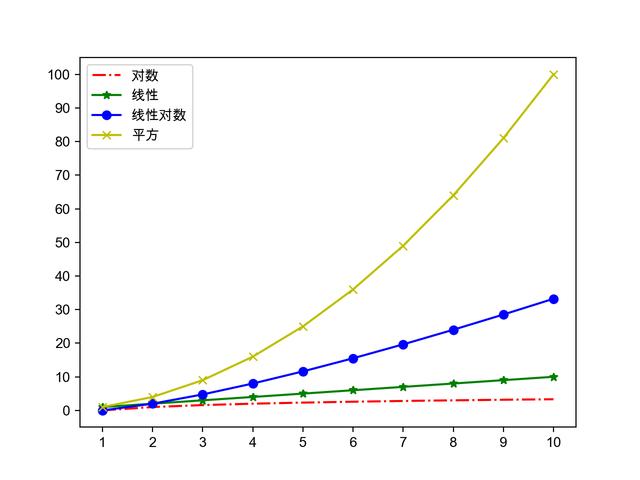Python语言进阶
- 数据结构和算法
- 算法:解决问题的方法和步骤
- 评价算法的好坏:渐近时间复杂度和渐近空间复杂度。
- 渐近时间复杂度的大O标记:



- 排序算法(选择、冒泡和归并)和查找算法(顺序和折半)
def select_sort(origin_items, comp=lambda x, y: x < y): """简单选择排序""" items = origin_items[:] for i in range(len(items) - 1): min_index = i for j in range(i + 1, len(items)): if comp(items[j], items[min_index]): min_index = j items[i], items[min_index] = items[min_index], items[i] return itemsdef bubble_sort(origin_items, comp=lambda x, y: x > y): """高质量冒泡排序(搅拌排序)""" items = origin_items[:] for i in range(len(items) - 1): swapped = False for j in range(i, len(items) - 1 - i): if comp(items[j], items[j + 1]): items[j], items[j + 1] = items[j + 1], items[j] swapped = True if swapped: swapped = False for j in range(len(items) - 2 - i, i, -1): if comp(items[j - 1], items[j]): items[j], items[j - 1] = items[j - 1], items[j] swapped = True if not swapped: break return itemsdef merge_sort(items, comp=lambda x, y: x <= y): """归并排序(分治法)""" if len(items) < 2: return items[:] mid = len(items) // 2 left = merge_sort(items[:mid], comp) right = merge_sort(items[mid:], comp) return merge(left, right, comp)def merge(items1, items2, comp): """合并(将两个有序的列表合并成一个有序的列表)""" items = [] index, index2 = 0, 0 while index1 < len(items1) and index2 < len(items2): if comp(items1[index1], items2[index2]): items.append(items1[index1]) index1 += 1 else: items.append(items2[index2]) index2 += 1 items += items1[index1:] items += items2[index2:] return itemsdef seq_search(items, key): """顺序查找""" for index, item in enumerate(items): if item == key: return index return -1def bin_search(items, key): """折半查找""" start, end = 0, len(items) - 1 while start <= end: mid = (start + end) // 2 if key > items[mid]: start = mid + 1 elif key < items[mid]: end = mid - 1 else: return mid return -1- 使用生成式(推导式)语法
prices = { 'AAPL': 191.88, 'GOOG': 1186.96, 'IBM': 149.24, 'ORCL': 48.44, 'ACN': 166.89, 'FB': 208.09, 'SYMC': 21.29}# 用股票价格大于100元的股票构造一个新的字典prices2 = {key: value for key, value in prices.items() if value > 100}print(prices2)说明:生成式(推导式)可以用来生成列表、集合和字典。
- 嵌套的列表
names = ['关羽', '张飞', '赵云', '马超', '黄忠']courses = ['语文', '数学', '英语']# 录入五个学生三门课程的成绩# 错误 - 参考http://pythontutor.com/visualize.html#mode=edit# scores = [[None] * len(courses)] * len(names)scores = [[None] * len(courses) for _ in range(len(names))]for row, name in enumerate(names): for col, course in enumerate(courses): scores[row][col] = float(input(f'请输入{name}的{course}成绩: ')) print(scores)- Python Tutor - VISUALIZE CODE AND GET LIVE HELP
- heapq、itertools等的用法
"""从列表中找出最大的或最小的N个元素堆结构(大根堆/小根堆)"""import heapqlist1 = [34, 25, 12, 99, 87, 63, 58, 78, 88, 92]list2 = [ {'name': 'IBM', 'shares': 100, 'price': 91.1}, {'name': 'AAPL', 'shares': 50, 'price': 543.22}, {'name': 'FB', 'shares': 200, 'price': 21.09}, {'name': 'HPQ', 'shares': 35, 'price': 31.75}, {'name': 'YHOO', 'shares': 45, 'price': 16.35}, {'name': 'ACME', 'shares': 75, 'price': 115.65}]print(heapq.nlargest(3, list1))print(heapq.nsmallest(3, list1))print(heapq.nlargest(2, list2, key=lambda x: x['price']))print(heapq.nlargest(2, list2, key=lambda x: x['shares']))"""迭代工具 - 排列 / 组合 / 笛卡尔积"""import itertoolsitertools.permutations('ABCD')itertools.combinations('ABCDE', 3)itertools.product('ABCD', '123')- collections模块下的工具类
"""找出序列中出现次数最多的元素"""from collections import Counterwords = [ 'look', 'into', 'my', 'eyes', 'look', 'into', 'my', 'eyes', 'the', 'eyes', 'the', 'eyes', 'the', 'eyes', 'not', 'around', 'the', 'eyes', "don't




















 557
557











 被折叠的 条评论
为什么被折叠?
被折叠的 条评论
为什么被折叠?








